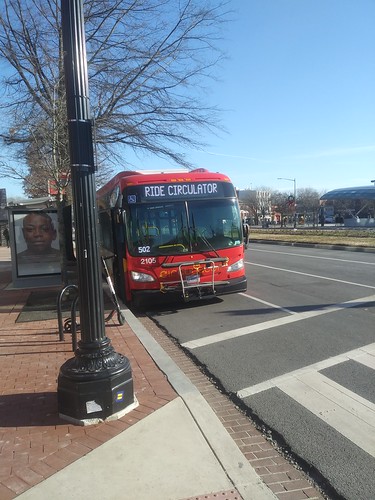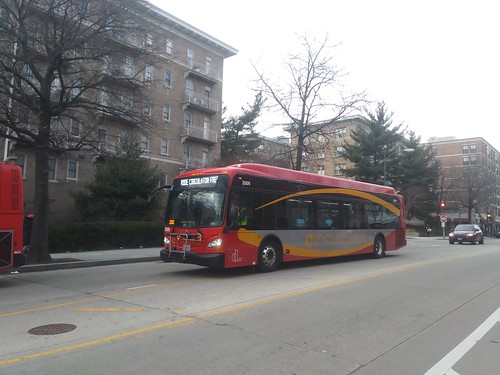Speaking of Free Circulator promotion
 I've been meaning to write about this all month, that the DC Circulator, a set of "circulator" bus routes serving Downtown, the National Mall, Georgetown, and other DC neighborhoods, which is provided by DC's Department of Transportation has been promoting bus ridership by making the month of February free.
I've been meaning to write about this all month, that the DC Circulator, a set of "circulator" bus routes serving Downtown, the National Mall, Georgetown, and other DC neighborhoods, which is provided by DC's Department of Transportation has been promoting bus ridership by making the month of February free.Yesterday it was announced that this is being extended through March ("D.C. Circulator service will now be free through March," Curbed DC).
I'm just not sure how effective and useful this is (cf. "Is making surface transit free the best transit investment DC can make?," 2016).
 From a marketing standpoint, I am of two minds. First, it's important to understand why people in cities with a relatively good transit system aren't regular users of transit ("What Makes Transit Successful? Survey Says It’s Frequency, Reliability and Shorter Travel Times," Government technology).
From a marketing standpoint, I am of two minds. First, it's important to understand why people in cities with a relatively good transit system aren't regular users of transit ("What Makes Transit Successful? Survey Says It’s Frequency, Reliability and Shorter Travel Times," Government technology).Definitionally, circulator routes--straightforward routes on major streets linking key activity centers and with frequent service so you don't have to worry about a time schedule--are supposed to address the primary concerns of frequency, reliability, and shorter travel times. Unless it's outlandishly high, price is a secondary factor.
I can understand the idea behind making an entire month or two free.
The concept is that you're getting the person used to taking transit, and it takes more than a day or two of regular ridership to build and regularize "transit taking" as routine.
But likely cost isn't enough of a barrier to changing their routines.
And after a day or two of free transit, the concept is no longer "new" or particularly exciting.
I'd probably instead make one day each month free or one day each quarter and market the h*** out of it. And I would promote free transit days as part of a year round calendar for transit promotion, which in turn would be a subset of a marketing plan for sustainable mobibility.
... or just make the Circulator free to begin with, as is done in other places, such as Baltimore.
"We get where you're going" marketing campaign for YRT/Viva transit, by Acart.
The biggest thing is to create and execute an annual marketing plan for transit. I tried to get the original marketing plan (YRT/Viva Marketing and Communication Plan 2006 (December 2005)) for the York Region Transit launch of the Viva BRT system in Greater Toronto about 12 years ago, but they wouldn't cough it up, saying that their current Transportation Master Plan is more relevant.
-- "Viva Case Study, Lee Jacobson Consultants
I don't think that's where DC Circulator is as the Transit Development Plan for the service doesn't address marketing at all.
Labels: provision of public services, strategic communications and marketing, transit marketing




6 Comments:
At least Circulator got rid of the stupid wrap on the buses that all said (Georgetown to Union Station) -- even on different routes.
I'm curious to know how the electric buses are doing. They are very pleasant on the street. I'm also glad when Circulator doesn't have the stupid flashing lights and announcements that WMATA buses have.
Off topic -- the bus priority signal on 16th and U has been turned on! After two or three years. Of course no bus driver understands what it is and it causes danger to cyclists who have been using that extra time. But at least it is on!
ads: https://www.youtube.com/watch?v=YQhFMk6QrwI
I'll have to check it out. The streetcar priority at H and 3rd Sts. NE has been on since the service started.
Good point about those elements of differentiation between Metrobus and Circulator.
===
thanks for the ad. I was thinking it happens about a piece, having looked at some Transperth ads and a couple others including GO (Ontario).
I think there's still opportunity, a bunch of places do ok, but still there's something missing.
question -- Baltimore released their "pilot study" results and said on the biggest day there were over 41,000 trips. I don't believe it... but I wonder can each scooter actually do about 20 trips without running out of juice?
https://www.bizjournals.com/baltimore/news/2019/02/25/baltimores-dockless-scooter-pilot-ends-thursday.html
I don't know what scooter they are using -- the picture they have is a LIME Segway scooter with an external battery pack.
Range on that is approximately 20 miles. So I could see maybe tops 15 short trips. Some of the scooter have internal models/GPS which would drain batteries while not being used, other "brainless" ones use the GPS signal from the last phone.
Limiting the speed to 10 MPH might also increase battery life.
I should write to the DOT inspector general about the waste of money on the TIGER grants for bus prioroity.
This is from the Lyft S1. As you remember they own Motivate as well as run their own scooters.
"
Bikes and Scooters
In 2018, we also generated revenue from subscription fees and single-use ride fees paid by riders of shared bikes and scooters to access our network of shared bikes and scooters. Subscription fees are recognized on a straight-line basis over the subscription period. Single-use ride fees are recognized upon completion of each ride. Revenue from the network of shared bikes and scooters was not material for the year ended December 31, 2018."
they spent 68M in "property and equipment and scooter fleet" but that may include actual land. Unclear.
"
The Company’s Light Vehicle fleet consists of bikes and scooters. Scooters are stated at cost less accumulated depreciation and are included in prepaid expenses and other current assets in the consolidated balance sheets. Depreciation is computed using a straightline method over the estimated useful life of the scooters, which is less than 12 months. As of December 31, 2018, the cost of scooters not yet placed in service was $23.3 million. As of December 31, 2018, the carrying value of scooters placed in service was not material. The Company did not have any scooters as of December 31, 2017. Bikes are included in property and equipment, net in the consolidated balance sheets."
Hi everyone, Are you into trading or just wish to give it a try, please becareful on the platform you choose to invest on and the manager you choose to manage your account because that’s where failure starts from be wise. After reading so much comment i had to give trading tips a try, I have to come to the conclusion that binary options pays massively but the masses has refused to show us the right way to earn That’s why I have to give trading tips the accolades because they have been so helpful to traders . For a free masterclass strategy kindly contact maryshea03@gmail.com for a free masterclass strategy. She'll give you a free tutors on how you can earn and recover your losses in trading for free..
Post a Comment
<< Home